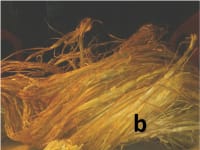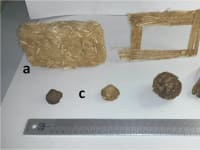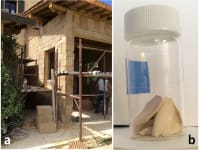Seeds are the beginning.
In a tiny volume, millions of years of evolution, packed in a smart code, the DNA. As soon as the smart code is activated by sunlight, water and ground, information unfolds to create the plant, hemp. What better way to transport potentiality through space and express it at destination?
1 kg of hemp seeds and 100 days under the astro-greenhouse will result in more than 1,000 kg of renewable matter, plus 100 kg of fresh seeds. Leaves, blooms and seeds are considered a super-food, having excellent nutritional properties; stems are used together with a small portion of seeds to produce engineering materials for structural panels/3D printing as discussed, bringing a future Martian exploration base closer to autonomy in terms of manufacturing capabilities. The same technology exploited on Earth is the quintessence of circular economy and brings to everybody plastic filaments 100% based on renewable resources.
a) Production of structural panels using 100% hemp materials. This is possible using two tools that we have developed: a fiber extractor (patent pending) that is able to avoid fiber chopping, hence guaranteeing fibers as long as the plant (4-7 m), and a steam explosion treatment to separate lignine from other less noble molecules. Once in possess of pure lignine and long fibers, structural panels are obtained by intertwining fibers and using lignine as a glue.
b) Polyunsaturated oils extracted from fresh seeds are perfect to produce biodegradable biopolymers, according to a chemical process we have developed; such thermoplastics can be easily drawn into wires and 3D printed to realize any object with a standard FDM module. Floor from squeezed seeds can be used again for dietary purposes.
The actual use of industrial hemp in phytopurification scenarios, to remediate heavy metal contamination of soils, confirms its capability to survive and grow even in hostile conditions, in the eventuality of finding hostile minerals as Martian soil components (sinjarite or jarosite, as already reported by NASA). A synergy with fungi, in the symbiotic association known as mycorrhiza, is also currently under study to further increase hemp growth speed and resistance to pollution above 40% if compared to the plant with no association.
Plastics and structural panels are the outcome.
We started our journey with 1 kg of hemp seeds and after 100 days we ended up with at least 500 kg of structural panels and 15 l of oil that can be converted in 10 kg of thermoplastics. Thermoplastics that can be printed into the shapes that we call world. A new world, fully sustainable. Also in another world, if necessary.
Figure 1: raw parts industrial hemp seeds (a) with extra long fibers (b), shives (c) and hurds (d).
Figure 2: semifinished parts (fibers and hurds), glued using lignine solution, to produce thermally insulating bricks (a), rigid frames (b) and compact tiles with 3D Gaussian shape (c).
Figure 3: finished parts bricks used in a construction site (a) and bio polymer prepared with our proprietary process from hemp seed oil (b).
Like this entry?
-
About the Entrant
- Name:Alessandro Chiolerio
- Type of entry:teamTeam members:Alessandro Chiolerio, Vincenzo Guarnieri, Sergio Bocchini, Giuseppe Ferraro, Paola Martino
- Patent status:pending








